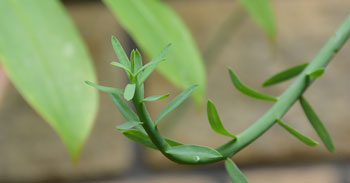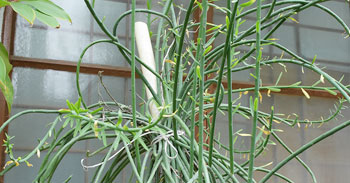KJC Medicinal Garden
Hambu balli
Sarcostemma acidum
Order: Asterids
Family: Asclepiadeae
Genus: Sarcostemma R.Br.
Species: S. acidum
Common Names: Khair, Khimp, Khuransi tanto, Art thor, Soma, Somavalli.
Native to China hills (Euphorbia Caducifolia Haines), India, Pakistan, Europe, Africa and America
Other plants of the same genus with medicinal properties
-
Asclepiasacida Roxb
Cynanchum acidum (Roxb.) Oken
Sarcostemma brevistigma Wight & Arn
- It is green, pubescent plant in young age that gradually turns glabrous with the age
- Perennial, almost leafless, straggling and jointed shrub with many green, cylindrical, fleshy glabrous with twinning branches having milky white latex
- Leaves: Very minute, reduced to scales, caducous, adpressed, and opposite.
- Fruits: Tapered follicles at both ends with flat, ovate, comose seeds.
- Stems are cylindrical, and of 3.0 - 6.0 in diameter
- Internodes are of 1.0 – 3.0 in length
Uses in Tradition systems of medicine
- The mildly acidulous milky juice is considered as the divine drink offered to Gods
- Used as a natural restorative to make the consumer allay the thirst and stay awakened and alert
- The stem juice of the plant is used as ear drops in otitis and rabid dog bites
- Roots acts as an antidote, are used in to treat snake bites, rabies, mental diseases, sinusitis, allergic rhinitis, and leprocy
- Latex of the plant is applied on wounds and cuts
- Considered useful in vitiated conditions of pitta, dipsia, viral infection, hydrophobia, psychopathy, and general debilit
- Finds mention in Vedas (The Rig Veda) as the Soma Plant
- Contains carbohydrates and glycosides
- Presence of proteins and free amino acids are found
- Steroids are present
Suggested Medicinal Properties
- Anti-hydrophobic
- Antipsychotic
- Antiviral
- Antimicrobial
- Antioxidant
- Anti-inflammatory
- Antispasmodic,
- Anti-fertility,
- Anti-ulcer activity
- Anxiolytic
- Narcoti
Active Phytochemicals
1. Sucrose, Malic Acid
2. Succinic Acid
3. Alkaloids
4. Phytosterols
5. α and β-amyrins
6. β-sitosterol
7. Lupeol and Lupeol acetate
8. Traces of tannins
Phytochemical studies of the crushed and powdered leaves contain alkaloids, phenolics, triterpenes, flavonoids, saponins, and carbohydrates.
References
Suresh Kumar Dev, Maya Sharma, Rajnish Srivastava and Pratim Kumar Choudhury.” Phytochemical and Pharmacological aspects of Sarcostemma acidum (Roxb.) Voigt.” Journal of Pharmacy Research. Vol 11. Issue 11. Sept 2017. Issue 11(11): 1429-1431
Rathore MS, Shekhawat NS. “Regeneration in Sarcostemma acidum (Roxb.) - an important medicinal plant of semi-arid ecosystem of Rajasthan, India.” Physiol Mol Biol Plants. 2013;19(2):269-275. doi:10.1007/s12298-012-0158-y

